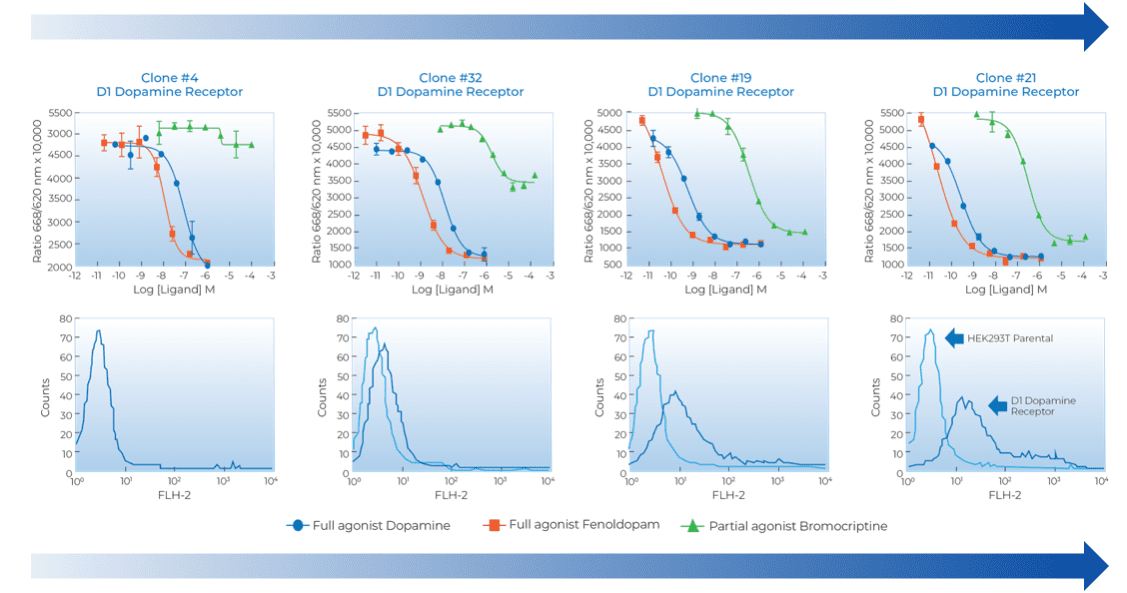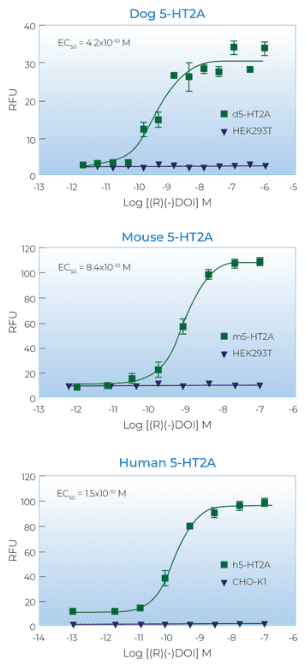MULTISCREEN™ STABLE CELL LINES
Combining Biologically-Relevant Assays with Cell Engineering For GPCR Targets and Beyond
Cell-based assays are essential throughout the drug discovery process. They are important for target validation, high throughput screening (HTS), rational drug design, and SAR lead optimization. Cell-based assays are also critical in the determination of safety and selectivity of new lead compounds. The most frequently used cells in cell-based assays are recombinant stable cell lines that heterologously express protein targets such as G-Protein Coupled Receptors (GPCRs). Stable cell lines are cornerstones in the discovery of new chemical entities.
NOT ALL CELL LINES ARE CREATED EQUAL
Stable cell line providers often resort to heavily engineered targets, modified signaling components and overamplified protein expression, all of which destroy the targets’ natural pharmacology.
Multispan’s MultiScreen™ stable cell line/assay development platform is designed to reflect true target pharmacology for robust high throughput screening. The MultiScreen™ platform is built on a foundation of rigorous science and proprietary knowhow. Multispan’s team of experts ensures a reliable process that each stable cell line is both biologically and pharmacologically relevant, and ready for HTS. We take extensive measures to achieve these mission-critical properties in every stable cell line we develop. We will share a few of these important properties in this article.
THE MULTISPAN APPROACH
GENE AND CDNA EXPRESSION
Firstly, we identify the specific disease-relevant variant and mutants of research interest for the protein target (Table 1). Secondly, Multispan’s propriety universal MultiScreen™ expression vector is optimized for robust cell surface expression of any transmembrane proteins like GPCRs, receptor tyrosine kinase receptors and transporters.
| GPCR Family | GPCR Target | Assay | GPCR Family | GPCR Target | Assay | ||
| Ca++ | cAMP | Ca++ | cAMP | ||||
| Bile Acid | GPBA | Opioid | mu | ||||
| GPBA Mutant W83G | mu Mutant Y150F | ||||||
| GPBA Mutant W83A | mu Mutant Y150A | ||||||
| GPBA Mutant V88L | mu Mutant M153A | ||||||
| GPBA Mutant Y89A | mu Mutant H299N | ||||||
| GPBA Mutant Y89H | mu Mutant H299A | ||||||
| GPBA Mutant F96A | Kynurenic acid | GPR35 | |||||
| GPBA Mutant W237A | GPR35 (short form) | ||||||
| GPBA Mutant W240A | GPR35 (long form) T108M | ||||||
| Cannabinoid | CB1 | Prokineticin | PK2 | ||||
| CB1a | PK2 mutant | ||||||
| CB1b | Purinergic | GPR17 (long form) | |||||
| Free Fatty-Acid | GPR120 | GPR17 (short form) | |||||
| GPR120L | |||||||
| Neuropeptide S | NPS | ||||||
| NPS(2) | |||||||
| NPSIle107 | |||||||
Table 1. Matched Wild-type vs Mutant and Canonical vs Variant GPCR Stable Cell Lines and Cell-based Assays
NATURAL PHARMACOLOGY
We also believe in keeping the recombinant cell system as natural as possible. When using readouts measuring endogenous cell signaling second messengers and functional fluorescence readouts It is always important to maintain the native pharmacology.
FUNCTIONAL SELECTION, A KEY DIFFERENTIATOR
Get what you screen for. Lastly, throughout the cell cloning and selection process, our team’s strong assay expertise in cell-based assays plays an important role. We leverage this expertise to enable clone selection directly in disease-relevant cell signaling pathways using tool compounds. In addition, 384-well high-throughput screening format is employed from the start.
As a result, each MultiScreen™ stable cell line is customized to closely resemble endogenous pharmacology in primary cells and uniquely positioned to deliver robust and physiologically relevant screening data.
HOW CAN MULTISPAN HELP YOU SUCCEED?
In the past decade and a half, the Multispan team has delivered hundreds of stable clones to pharmaceutical researchers where detection of exquisitely small differences between compounds in HTS and SAR is needed. This unique capability at Multispan has been battle-tested and our team hasn’t failed to deliver, no matter how rare the specific phenotypic event is in the cell pool. Not only Multispan’s pharmaceutical partners, but also the Multispan team inhouse rely on these high-performance stable cell lines to support HTS and weekly SAR compound screening for our partners.
Here is an example that illustrates how Multispan’s approach and rigorous clone process can make disease-specific “Designer Pharmacology” possible (Figure 1).
Efficacy-gap Reduction between Partial Agonist and Full Agonists
in Dose-Response Curve cAMP Assay in D1-HEK293 Stable Clones

Correlation with Increased D1-Receptor Surface Expression
in the D1-HEK293 Stable Clones Measured by FACS
SIGNATURE MULTISCREEN™ GPCR STABLE CELL LINE SOLUTIONS
Our stable cell lines expressing GPCRs offer the following unique benefits:
- Preservation of all endogenous cell signaling pathways: Calcium, cAMP, beta-arrestin, pGRK2, IP-1, pERK, pNFκB, radioligand binding, GTPγS, chemotaxis, cytokine secretion, cell proliferation, Luciferase reporter and internalization
- Gold standard for studying all GPCR cell signaling-biases in ONE cell line
- Multi-screen capability in the same cell line across multiple assays for counter screens
- Available as division-arrested cells and membranes
- Rigorously validated in MultiScreen™ No Wash Calcium Assay and cAMP Assay Kits
- Expression and pharmacology-matched human and ortholog protein target pairs, including rhesus monkey, cynomolgus monkey, dog, ferret, rabbit, rat, and mouse (Figure 2 and Table 2)
Collectively, Multispan’s stable cell line generation platform is highly differentiated to mimic native responses in multiple physiologically disease-relevant pathways by minimizing modifications in our MultiScreen™ expression vector. Your success is our priority. Multispan employs an assay-centric screening approach customized to meet each project’s need.
We enjoy learning the biology of each target and eveloping high-performance cell lines for disease-relevant assays. It serves our mission to help “make better medicine, one assay at a time”.

Figure 3. Pharmacology-Matched Human, Dog and Mouse Serotonin Receptor 5-HT2A MultiScreen™ Stable Cell Lines for Calcium Assays
Please email info@multispaninc.com for more. Let’s discuss how MultiScreen™ stable cell lines can uniquely empower your program.
| Receptor Family | Receptor | Species | Assay | Receptor Family | Receptor | Species | Assay | ||
| Ca++ | cAMP | Ca++ | cAMP | ||||||
| Adenosine | A2A | human | Leukotriene B4r | BLT2 | human | ||||
| A2A | mouse | BLT2 | Rhesus monkey | ||||||
| A2B | human | BLT2 | mouse | ||||||
| A2B | rat | Lyso-phospholipid | LPA1 | human | |||||
| Bile Acid | GPBA | human | LPA1 | mouse | |||||
| GPBA | rat | LPA1 | rat | ||||||
| GPBA | mouse | LPA5 | human | ||||||
| Bombesin | BB1 | human | LPA5 | mouse | |||||
| BB1 | rat | S1P2 | human | ||||||
| Bradykinin | B1 | human | S1P2 | mouse | |||||
| B1 | mouse | S1P2 | rat | ||||||
| B2 | human | S1P3 | human | ||||||
| B2 | mouse | S1P3 | mouse | ||||||
| B2 | rat | S1P3 | rat | ||||||
| B2 | dog | S1P4 | human | ||||||
| B2 | monkey | S1P4 | mouse | ||||||
| B2 | guinea pig | S1P4 | rat | ||||||
| B2 | rabbit | Melanin-Concentrating Hormone |
MCH1 | human | |||||
| Calcium-Sensing | CaSR | human | MCH1 | rat | |||||
| CaSR | rat | Melatonine | MT2 | human | |||||
| Cannabinoid | CB1 | human | MT2 | mouse | |||||
| CB1 | mouse | MT2 | rat | ||||||
| CB1 | mouse | Metabotropic Glutamate | mGlu2 | human | |||||
| Chemokine | CCR6 | human | mGlu2 | rat | |||||
| CCR6 | mouse | mGlu3 | human | ||||||
| CCR8 | human | mGlu4 | dog | ||||||
| CCR9 | dog | mGlu4 | human | ||||||
| CCR9 | human | mGlu4 | mouse | ||||||
| CCR9 | mouse | mGlu4 | rat | ||||||
| CCR9 | rat | Muscarinic | M3 | human | |||||
| Endothelin | ETA | human | M3 | mouse | |||||
| ETA | rat | M3 | rat | ||||||
| Free-Fatty Acid | GPR119 | human | Neuropeptide S | NPS | human | ||||
| GPR119 | mouse | NPS | mouse | ||||||
| GPR120 | human | Neuropeptide W/B | NPBW1 | human | |||||
| GPR120 | mouse | NPBW1 | rat | ||||||
| GPR120 | rat | Neuropeptide | Y2 | human | |||||
| GPR40 | human | Y2 | rat | ||||||
| GPR40 | cynomolgus monkey | Opioid | delta | human | |||||
| GPR40 | dog | delta | rat | ||||||
| GPR40 | mouse | kappa | human | ||||||
| GPR40 | rat | kappa | rat | ||||||
| GPR40 | rhesus monkey | mu | human | ||||||
| GPR41 | human | mu | rat | ||||||
| GPR41 | mouse | NOP | human | ||||||
| GPR41 | rat | NOP | rat | ||||||
| GPR43 | human | Kynurenic acid | GPR35 | human | |||||
| GPR43 | mouse | GPR35 | dog | ||||||
| GPR43 | rat | GPR35 | mouse | ||||||
| GPR43 | dog | Oxysterol | EBI2 | human | |||||
| GPR43 | cynomolgus monkey | EBI2 | mouse | ||||||
| GPR43 | rhesus monkey | EBI2 | mouse | ||||||
| Ghrelin | Ghrelin | human | Prostanoid | EP2 | human | ||||
| Ghrelin | mouse | EP2 | mouse | ||||||
| Glucagon | GIP | human | EP2 | rat | |||||
| GIP | mouse | Purinergic | GPR17 | human | |||||
| GIP | rat | GPR17 | mouse | ||||||
| GIP | dog | GPR17 | rat | ||||||
| GIP | rabbit | P2Y2 | human | ||||||
| GIP | rhesus monkey | P2Y2 | rat | ||||||
| GIP | ferret | P2Y12 | human | ||||||
| GLP-1 | human | P2Y12 | rat | ||||||
| GLP-1 | cynomolgus monkey | P2Y14 | human | ||||||
| GLP-1 | rat | P2Y14 | rat | ||||||
| GLP-1 | dog | P2Y14 | Cynomolgus monkey | ||||||
| GLP-1 | mouse | Serotonin | 5-HT2A | human | |||||
| GLP-2 | human | 5-HT2A | mouse | ||||||
| GLP-2 | rat | 5-HT2A | dog | ||||||
| Glucagon | human | 5-HT2B | mouse | ||||||
| Glucagon | cynomolgus monkey | 5-HT4A | human | ||||||
| Glycoprotein Hormone | TSH | human | 5-HT4A | mouse | |||||
| TSH | rat | Trace Amine | TA1 | human | |||||
| Histamine | H1 | human | TA1 | rat | |||||
| H1 | mouse | Urotensin | UT | human | |||||
| H3 | human | UT | rat | ||||||
| H3 | mouse | Vasopressin/ Oxytocin | OT | human | |||||
| H4 | human | OT | rabbit | ||||||
| H4 | mouse | V1A | human | ||||||
| KiSS1-Derived Peptide | KiSS1 | human | V1A | rabbit | |||||
| KiSS1 | rat | V1B | human | ||||||
Table 2. Examples of Multispan’s Ortholog GPCR Stable Cell Lines for Cell-Based Assays

Recent Comments